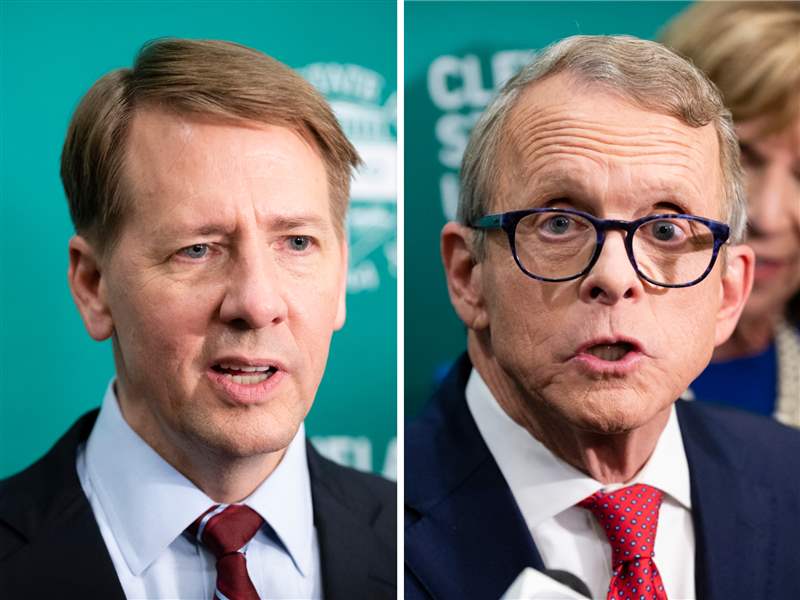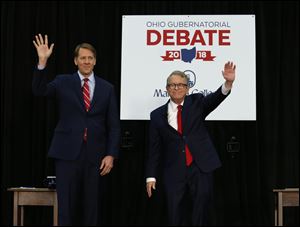
Poll shows governor's race is a dead heat
10/9/2018
Democrat Richard Cordray and Republican Mike DeWine are locked in a statistical tie, according to pre-election polls.
ASSOCIATED PRESS PHOTOS

Democratic gubernatorial candidate Richard Cordray, left, and Ohio Attorney General and Republican gubernatorial candidate Mike DeWine wave to the crowd before a recent debate.
COLUMBUS —The race for Ohio governor between the two major-party candidates is locked in a statistical tie roughly a month out from the election, according to a poll released Tuesday.
In fact, with the exception of the U.S. Senate, most of races for statewide office on the ballot are extremely tight, according to the poll by Cleveland’s Baldwin-Wallace University.
The poll also shows support for Issue 1 at 48 percent compared to opposition of 31 percent. The controversial ballot issue would amend the state constitution to downgrade low-level, non-violent drug felonies to misdemeanors and require any financial savings experienced in state prisons be put into addiction treatment.
In the governor’s race, Republican Attorney General Mike DeWine had 42.2 percent to Democratic former federal consumer watchdog Richard Cordray’s 39.2 percent — within the margin of error of plus or minus 3.5 percentage points.
The leaves 18.6 percent of the electorate to fight over as voters begin to cast absentee and early in-person ballots on Wednesday.
The race becomes even tighter when the two other candidates — Libertarian Travis Irvine and the Green Party’s Constance Gadell-Newton — are factored in. Mr. DeWine leads with 39.7 percent followed by Mr. Cordray with 37.1 percent; Mr. Irvine, 4.3 percent; and Ms. Gadell-Newton, 3.4 percent.
Undecided voters account for 15.4 percent.
“This tells us voters are still thinking about these races with many, 18 to 27 percent, undecided,” said Tom Sutton, political science professor and director of the university’s Community Research Institute that conducted the poll.
“It reflects the continued split between Ohioans—Democrats, Republicans, and the larger portion identifying as independent,” he said. “Voters don’t know who the candidates are, so they’re waiting to see how they will vote.”
The poll of 1,017 likely voters was conducted between Sept. 28 and Oct. 8 — the date of what may have been the last debate between the two candidates.
In the U.S. Senate race, Cleveland Democratic incumbent Sen. Sherrod Brown continues to hold down a double-digit lead, 49.5 percent to 33 percent for his Republican opponent, northeast Ohio’s U.S. Rep. Jim Renacci.
Mr. Renacci is backed by President Donald Trump, who remains underwater with likely Ohio voters in terms of their opinion of his performance. Just under 50 percent say they disapprove of the President’s job performance while just under 45 percent approve.
By comparison, Republican Gov. John Kasich, Mr.Trump’s former opponent for the 2016 GOP nomination, carries a 49 percent approval rating compared to 32 percent who disapprove. But Ohioans generally would prefer that he not try to run again for president in 2020. Nearly 47 percent said he should not run compared to 31 percent who say he should.
In other statewide races:
● Attorney General: State Auditor Dave Yost leads former Cleveland federal prosecutor Steve Dettelbach 38.1 percent to 33.7 percent. That leaves a large 28.2 percent still undecided.
● Secretary of State: State Rep. Kathleen Clyde (D., Kent) and state Sen. Frank LaRose (R., Hudson) are deadlocked at 32.6 percent. Libertarian Dustin Hanna has 7.2 percent while 27.6 percent remain undecided.
● Auditor: Also statistically tied, Democratic former congressman Zack Space has 32.3 percent to 31.3 percent for state Rep. Keith Faber (R., Celina) and 6.4 percent for Libertarian Robert C. Coogan. Thirty percent are undecided.
● Treasurer: Cincinnati attorney Rob Richardson, the Democrat, and state Rep. Robert Sprague (R., Findlay) are also statistically tied—33.2 percent to 31.1 percent, respectively. That leaves 6.4 percent for Libertarian Paul Curry with 29.3 percent undecided.
There are also still a lot of voters up for grabs on Issue 1 with 21.7 percent saying they are undecided.
While the generic question as to how voters plan to vote in congressional races seems to suggest an edge for Democrats in general, Mr. Sutton said he is not yet seeing a sign of that “blue wave” Democrats have been counting on.
“The real factor is turnout,” he said. “Whether that occurs or not will depend on how voters are feeling about whatever motivates them and whether they’re voting by absentee ballot—factors like the Brett Kavanaugh hearings, the Trump administration, the MeToo movement, and possibly trade tariffs….
“On the Republican side in rural counties where the vast majority reliably votes, there is high enthusiasm among those identifying as Republican for President Trump,” Mr. Sutton said. “That has been moving in an upward direction the last few weeks. The Kavanaugh confirmation may be helpful, and Republicans tend to be more reliable than Democrats.”
Contact Jim Provance at jprovance@theblade.com or 614-221-0496.